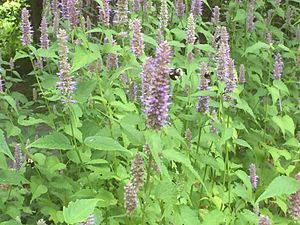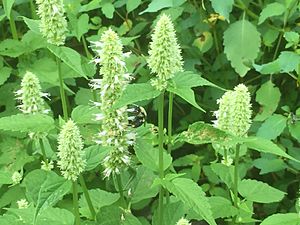Agastache foeniculum facts for kids
Quick facts for kids Agastache foeniculum |
|
|---|---|
 |
|
| Scientific classification | |
| Genus: |
Agastache
|
| Species: |
foeniculum
|
Agastache foeniculum is a special plant often called anise hyssop. You might also hear it called blue giant hyssop or lavender giant hyssop. It's a type of plant that grows back every year, belonging to the mint family.
This plant naturally grows across much of north-central and northern North America. You can find it in places like the Great Plains and other prairie areas, and even in parts of Canada. Anise hyssop is quite tough! It can handle dry weather and deer usually don't eat it. Plus, it's a favorite for many creatures like hummingbirds, butterflies, bumblebees, honeybees, carpenter bees, and even night-flying moths.
Even though anise hyssop is in the same family as regular hyssop, they are not super close relatives. The hyssop plant (from the Hyssopus group) has about 10 to 12 different kinds. These are usually found from the eastern Mediterranean area all the way to central Asia.
What Does Anise Hyssop Look Like?
This plant typically grows to be about 2 to 4 feet (60 to 120 cm) tall. It spreads out to about 1 foot (30 cm) wide, growing in a neat, upright bunch. Its flowers grow in pretty clusters, often at the top of the plant.
The leaves are shaped like an oval and have small teeth along their edges. The underside of the leaves has a slightly white color. Anise hyssop blooms from June to September. Its bright lavender flowers become even more colorful towards the tips. Just one plant can grow more than 90,000 tiny flowers! It has a strong main root that grows straight down, called a taproot.
Why is Anise Hyssop Important for Pollinators?
Anise hyssop is known as one of the best plants for feeding pollinators. These are the creatures that help plants make seeds. In 1969, a gardening book called Rodale's Encyclopedia of Organic Gardening said something amazing. It claimed that if you planted one acre of anise hyssop, it could feed 100 honeybee hives!
The flowers bloom for a very long time, often from June until the first frost. During this time, you can see bees on the flowers from morning until evening. Many garden writers agree that the plant's many flowers provide lots of food for bees, butterflies, and hummingbirds.
How is Anise Hyssop Used?
Native Americans used anise hyssop for many purposes. They used it as a medicine for things like coughs, fevers, wounds, and diarrhea.
Today, the soft, anise-scented leaves are used in different ways. You can use them to flavor food, make a tea, or add them to potpourri to make a room smell nice. The leaves can also be crumbled into a salad. Bees especially love the purple flower spikes. They use the nectar from these flowers to make a light and fragrant honey.


